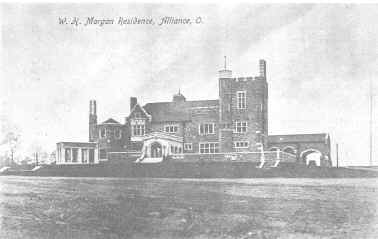 Almost five years were required to complete Alliance's most magnificent residence, Glamorgan. Colonel William Henry Morgan, who succeeded his father as president of the Morgan Engineering Company, began to build his home in the summer of 1903. Because of his Welsh heritage the design of the building was similar to that of a Welsh castle. The outside walls, which were three and one half feet thick at the bottom, took 96 carloads of Vermont marble to construct. Of the nearly 50 rooms inside, many were decorated with molded plaster, rich hand carved woodwork, beautiful inlaid floors, and silk tapestries.
Almost five years were required to complete Alliance's most magnificent residence, Glamorgan. Colonel William Henry Morgan, who succeeded his father as president of the Morgan Engineering Company, began to build his home in the summer of 1903. Because of his Welsh heritage the design of the building was similar to that of a Welsh castle. The outside walls, which were three and one half feet thick at the bottom, took 96 carloads of Vermont marble to construct. Of the nearly 50 rooms inside, many were decorated with molded plaster, rich hand carved woodwork, beautiful inlaid floors, and silk tapestries.
A magnificent pipe organ, one of the attractions at the 1904 St. Louis Exposition, was brought to the castle at the close of the Exposition. Unfortunately, it was badly damaged in the fire which destroyed part of the structure on September 26, 1945, and had to be removed.
Unlike the dark, cold medieval castles after which it was patterned, Glamorgan was filled with the most up to date conveniences. It had its own electric power plant to supply electricity for lighting, steam boilers for heating, a built in vacuum system for sweeping, an elevator, and a system of telephones which connected the many rooms of the house.
The land in front of the mansion had once been the area from which clay had been taken to make the bricks for many of the early Alliance buildings. Among them were the Opera House, the Hester block in Freedom, and part of the Haines House.
Colonel Morgan died in 1928. His widow continued to live in the castle for ten more years, at which time she sold the property to the Alliance Elks Lodge. The Lodge members used it until 1965 when it was sold to the Alliance Machine Company. In 1972 Glamorgan was included in the National Park Service's Register of Historical Places. It was recently acquired by the Alliance Board of Education and will probably be remodeled and used for school offices.
[See Alliance Memory for more photos of Glamorgan through the years.]
